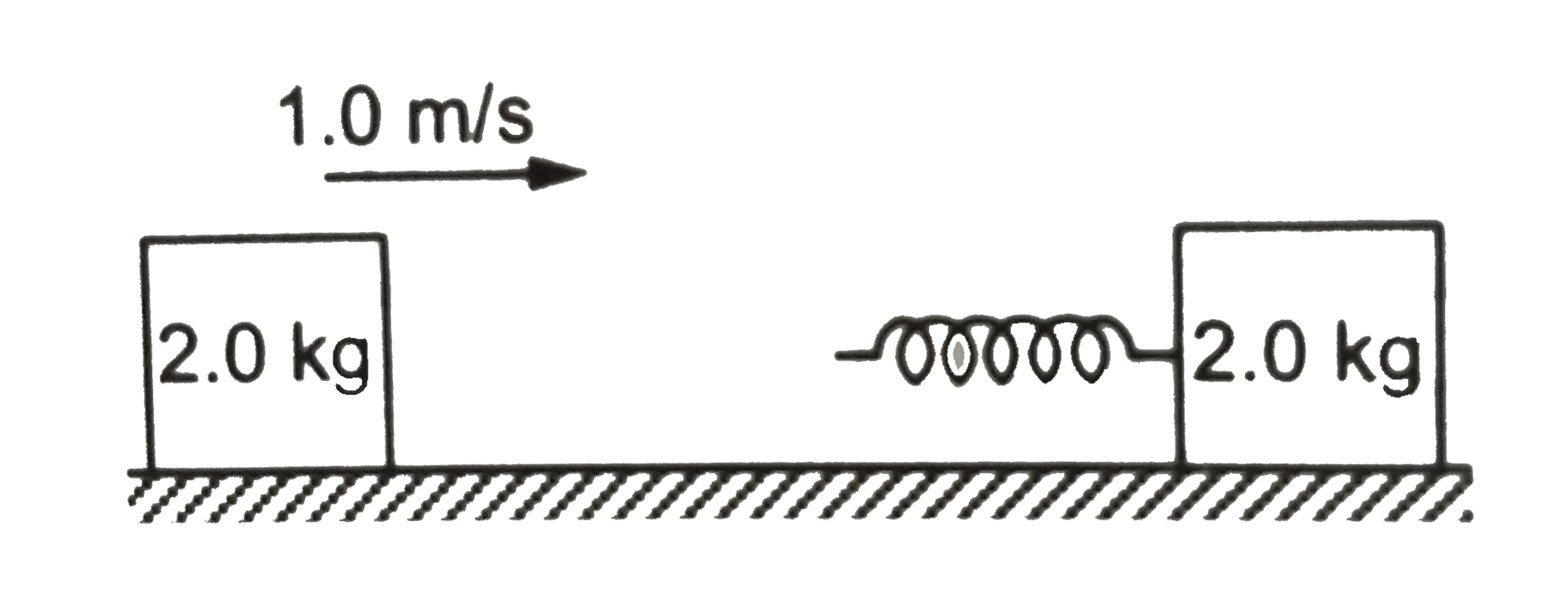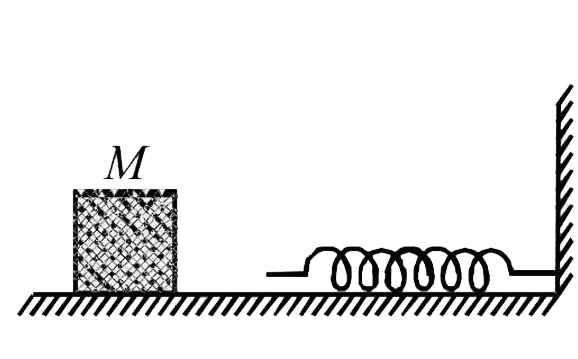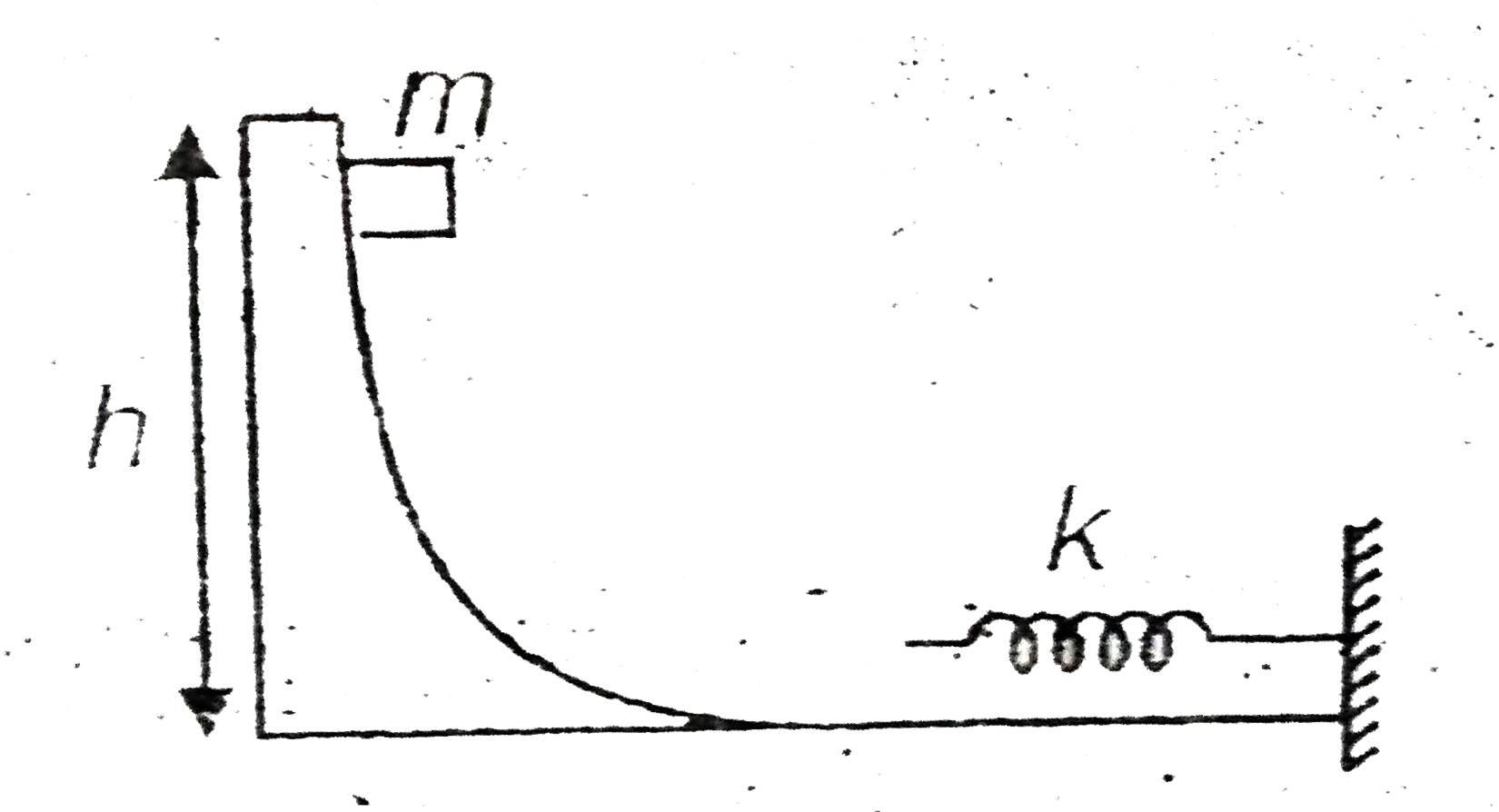A block of mass 2.0 kg is moving on a frictionless horizontal surface with a velocity of 1.0 m/s figure towards abnother block of equal mass kept at rest. The spring constant of the spring fixed at one end is 100 The spring constant of the spring fixed at one end is 10 N/m. Find the maximum compression of the spring.

Mass of each block MB=2kg
Initial velocity of the 1st block
v=1msec
Va=1msec
Vb=0msec
Spring constantof the spring =100N/m

The block A strikes the spring with a velocity 1m/sec.
After teh colision, its velocilty deceases continuously adn at an instant the whole system(Block A+the compound spring +Block B) moves together wilth a common velocity.
Let teh velocity be V.
Using conservation of energy,.
(12)MAV2A+(12)MbV2B
=(12)MAV2+(12)MBV2+(12)kx2
(12)×2(1)2+0
=(12)+(12)xv2+(12)x2×100
(whenx=maxiμmcompresionofspr∈g)<br>rarr 1−2v2=50x2..........i
AsthereisnoexterNAlforce∈thehorizontaldirection,themomentumshod––beconserved.<br>rarr M_AV_A+M_BV_B=(M_A+M_B)V<br>rarr 2xx1=4xxV<br>rarr V=(1/2)m/sec.....ii<br>pu∈g∈equatio∩i<br>1=2xx(1/4)+50x^2<br>rarr (1/4)=50x^2<br>rarr (1/4)=50x^2<br>rarr x^2=1/100m^2<br>rarr x=(1/10)m<br>=0.1m=10cm
Topper's Solved these Questions
- CENTRE OF MASS, LINEAR MOMENTUM, COLLISIONBOOK - HC VERMACHAPTER - CENTRE OF MASS, LINEAR MOMENTUM, COLLISIONEXERCISE - Objective 2
11 Videos
- CALORIMETRYBOOK - HC VERMACHAPTER - CALORIMETRYEXERCISE - Exercises
18 Videos
- CIRCULAR MOTIONBOOK - HC VERMACHAPTER - CIRCULAR MOTIONEXERCISE - Exercises
30 Videos
Similar Questions
A block of mass 2 kg is moving on a frictionless horizontal surface with a velocity of 1m/s towards another block of equal mass kept at rest. The spring constant of the spring fixed at one end is 100N/m. Find the rnaximum compression of the spring

View SolutionA 16kg block moving on a frictionless horizontal surface with a velocity of 4m/s compresses an ideal spring and comes to rest. If the force constant of the spring be 100N/m, then how much is the spring commpressed ?
View Solution
Knowledge Check
A solid sphere of mass 2 kg is rolling on a frictionless horizontal surface with velocity 6m/s. It collides on the free and of an ideal spring whose other end is fixed. The maximum compression produced in the spring will be
(Force constant of the spring = 36 N/m)A√14mB√2.8mC√14mD√0.7mA solid sphere of mass 2 kg is rolling on a frictional horizontal surface with velocity 6 m/s. It collides on the free end of an ideal spring whose other end in fixed. The maximum compression produced in the spring will be (Force constant of the spring is 36 N/m).
A√14mB√2.8 mC√1.4 mD√0.7 mThe block of mass M moving on the frictionless horizontal surface collides with the spring constant k and compresses it by length L . The maximum momention of the block after collision is
 AkL22MB√MkL(c)SCML2kDzero
AkL22MB√MkL(c)SCML2kDzero
Each of the blocks shown in figure has mass 1 kg. The rear block moves with a speed of 2 m/s towards the front block kept at rest. The spring attached to the front block islight and has a spring constant 50 N/m. find the maximum compression of the spring.

View SolutionBlock of mass m is pushed towards a horizontal spring as shown in figure , with initial speed u .

Spring constant of the spring is K and floor is smooth . Calculate maximum possible compression of the spring .
View SolutionA spring of force constant 24N/m is resting on a frictionless horizontal surface. A force of 10N is applied on the block of mss 4kg at one end of the spring. What is the speed of the block when it has been moved through a distance of 0.5 m ?
View SolutionA block of mass m is released from a height h from the top of a smooth surface. There is an ideal spring of spring constant k at the bottom of the track. Find the maximum compression in the spring (Wedge is fixed)

View SolutionThe block of mass m is released when the spring was in its natrual length. Spring constant is k. Find the maximum elongation of the spring.

View Solution
